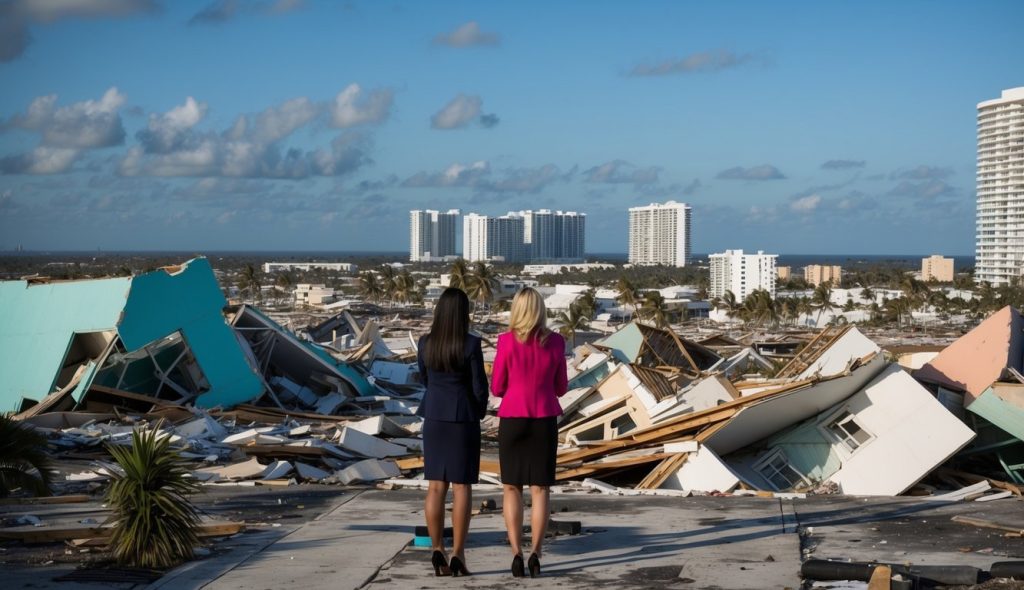Miami Housing Market Collapse: What Investors Need to Know

Miami’s real estate market is experiencing a significant shift as demand plummets to unprecedented levels. Sales have dropped 50% from their pandemic peak and currently sit 30% below the long-term average, signaling a major transformation in one of America’s hottest housing markets.
The signs of market stress are becoming more evident, with dramatic price reductions appearing across the region. Property owners are adjusting their expectations as the market cools, with some listings seeing price cuts of up to 40%.
Entry-level properties have become increasingly scarce, as homes under $500,000 have decreased by nearly 80% in the past five years. This shift presents both challenges and opportunities for investors who need to adapt their strategies to the changing market dynamics.
Key Takeaways
- Miami housing sales have plunged below historical averages while inventory continues to rise
- Property values are experiencing significant downward pressure with substantial price reductions
- Cash buyers are retreating from the market as investment opportunities shift
The Current State Of Miami’s Real Estate Market
Miami’s real estate market is experiencing a dramatic shift. Home sales have plummeted 50% from their pandemic peak, signaling a significant change in market dynamics.
The available housing inventory has risen substantially. You’ll find approximately 51,000 homes on the market, marking one of the highest inventory levels recorded in the region’s history.
Price trends vary across counties. Palm Beach shows a 2.5% decrease, while Broward County has declined 1.1%. Miami-Dade County maintains a slight 1.8% increase, though market indicators suggest this may change.
The market appears to be transitioning to favor buyers, with increased housing inventory and declining builder confidence affecting market conditions.
High mortgage rates near 7% continue to impact buyer demand. This factor, combined with elevated inventory levels, creates challenging conditions for sellers in the current market.
Properties in Miami-Dade County are currently valued 20% above historical averages. This premium pricing, coupled with reduced demand, suggests potential price adjustments may occur in the coming months.
Why Miami’s Downturn Isn’t “Just A West Coast Problem”

Miami’s housing market decline mirrors patterns seen across Florida, not just in western states. Your local real estate challenges stem from statewide economic pressures, with home prices dropping 12% since January 2025.
Tampa and Orlando face similar struggles, with price declines of 15% and 14% respectively in the first quarter of 2025. These numbers demonstrate the widespread nature of Florida’s housing correction.
Rising inflation has pushed mortgage rates to 8.2% statewide, affecting buyers from Pensacola to Key West. This financial pressure transcends regional boundaries and impacts all Florida markets equally.
The data shows Miami’s housing challenges match trends in Jacksonville and Fort Myers, where listings stay on the market 45-60 days longer than in 2024. Your local market reflects a broader Florida pattern rather than copying West Coast dynamics.
Key Market Indicators Across Florida
- Miami: -12% price change
- Tampa: -15% price change
- Orlando: -14% price change
- Jacksonville: -11% price change
Property investors moving away from Florida markets signal a statewide shift. You’ll notice reduced institutional buying in all major Florida metros, not just Miami or West Coast locations.
New construction permits dropped 30% across Florida’s metropolitan areas in early 2025. This decline spans the entire state, proving Miami’s slowdown connects to Florida-specific factors rather than West Coast influences.
Understanding The 20% Overvaluation Problem
Miami’s housing market currently shows signs of significant overheating. Home prices in South Florida are 35% above their expected value, creating substantial risks for buyers and investors.
When you purchase property in an overvalued market, you face increased exposure to potential price corrections. Your investment becomes more vulnerable as the gap between actual prices and fundamental values widens.
The current situation mirrors patterns from previous market cycles, particularly the 2008 housing crisis. Back then, Miami also experienced rapid price appreciation followed by a sharp decline.
The rising inventory of unsold homes signals trouble ahead. More properties sitting on the market typically precede price reductions as sellers compete for fewer buyers.
Your investment risk increases due to several factors in Miami’s market:
- Inflated purchase prices relative to local incomes
- Higher carrying costs through property taxes and insurance
- Reduced potential for appreciation in the near term
- Greater likelihood of negative equity if prices correct
Miami’s market attracts various forms of speculation, which can artificially inflate prices beyond sustainable levels. You should carefully evaluate any property purchase against long-term pricing fundamentals.
Key Indicators Real Estate Investors Should Monitor

You need to track median home prices across different Miami neighborhoods. High interest rates and insurance costs are affecting property values differently in various areas.
Monitor the sales-to-inventory ratio monthly. This metric reveals supply and demand dynamics – a ratio below 6 months typically indicates a seller’s market, while higher ratios suggest a buyer’s market.
Pay attention to mortgage application rates and approval percentages. These numbers signal potential market slowdowns or accelerations before price changes become visible.
Consumer sentiment surveys provide early warnings of market shifts. When confidence drops, housing demand often follows within 3-6 months.
Watch for price divergences between Miami-Dade, Broward, and Palm Beach counties. Areas showing unusual patterns compared to neighboring regions often indicate coming market changes.
Miami’s current bubble risk status makes it essential to track foreclosure rates and distressed property listings. Rising numbers in these categories can signal broader market stress.
Key metrics to monitor daily:
- Days on market for new listings
- Price reduction percentage
- Pending sales volume
- New construction permits
- Local employment data
Potential Investment Strategies During A Market Correction

When Miami’s housing prices start to decline, you can focus on undervalued neighborhoods with strong fundamentals like good schools, low crime rates, and improving infrastructure.
Consider properties near planned development projects or areas with upcoming transportation improvements. These locations often maintain value better during market corrections and recover faster.
The rental market typically strengthens during housing downturns. As fewer people buy homes, rental demand increases, creating opportunities for steady cash flow from investment properties.
Key Investment Tactics:
- Buy distressed properties at 20-30% below market value
- Focus on multi-family units in stable neighborhoods
- Look for properties with value-add potential through renovations
- Maintain high cash reserves for unexpected opportunities
Your timing strategy should emphasize long-term appreciation rather than quick profits. Market corrections can last 12-24 months, so prepare for an extended buying window.
Watch for properties in areas where insurance costs remain manageable. High insurance premiums can significantly impact your investment returns.
Consider forming partnerships with local property managers and real estate agents who can alert you to off-market deals and price reductions before they become public.
Lessons From Miami’s Last Housing Crash
Miami’s 2008 housing crash taught valuable lessons about market cycles and recovery patterns. The median home price dropped 50% between 2007-2011, creating opportunities for strategic buyers who recognized the market bottom.
You can spot potential market bottoms by watching key indicators: rising foreclosure rates, inventory levels above 12 months, and sharp price reductions becoming common. These signals emerged clearly in 2009-2010 during the last major correction.
Properties in areas under $500,000 proved especially resilient during the recovery phase. West Palm Beach neighborhoods with strong rental demand rebounded particularly well.
Natural disasters and structural concerns play crucial roles in market corrections. After Hurricane Andrew in 1992, properties with documented structural inspections and hurricane protection retained more value during downturns.
The 2008 crash revealed that cash buyers gain significant advantages during downturns. You’ll find better negotiating power and faster closing times without mortgage contingencies.
Recovery typically follows a “U” shape rather than “V” pattern. The 2008-2012 recovery took roughly 4 years for prices to stabilize before appreciating again. This gradual process allows time for careful property evaluation and strategic purchases.
Key buying opportunities emerge when:
- Foreclosure rates spike above historical averages
- Sellers accept 15%+ price reductions
- Construction starts hit multi-year lows
- Local employment shows signs of stabilizing
Frequently Asked Questions
Miami’s real estate market faces significant shifts in 2025, with pending home sales dropping 17.9% and property values showing volatility amid changing market dynamics.
What are the primary factors that led to the downturn in Miami’s housing market?
Rising interest rates have dampened buyer enthusiasm and reduced mortgage application volumes.
Insurance costs have skyrocketed, making monthly payments unaffordable for many potential buyers.
Market speculation and investor pullback have contributed to reduced demand in previously hot neighborhoods.
How has the recent housing market collapse in Miami affected property values and sales?
Transaction volumes have declined significantly as buyers remain hesitant to commit in uncertain conditions.
Home values have stalled after rising from $346,000 in 2019 to approximately $580,000.
You’ll find more properties staying on the market longer, giving buyers increased negotiating power.
What measures are being taken by local authorities to stabilize the Miami housing market?
Local government has implemented new zoning regulations to encourage affordable housing development.
Tax incentives now target first-time homebuyers to stimulate market activity.
New programs offer down payment assistance to qualified buyers in specific income brackets.
What trends are emerging in the Miami housing market following the collapse?
Cash buyers have gained leverage in negotiations as financing becomes more challenging.
Multi-family housing developments have increased in popularity as single-family home sales slow.
Suburban areas are seeing increased interest as buyers seek more affordable options.
How have rental markets in Miami been impacted by the changes in the housing market?
Rental rates have surged 27% since 2019, putting additional pressure on residents.
Miami now ranks as the second most expensive rental market in the country.
Property investors are increasingly converting unsold units to rentals, expanding rental inventory.
What is the outlook for Miami’s housing market recovery in the near term?
Market stabilization depends heavily on interest rate trajectories and economic conditions.
You can expect continued price adjustments as the market seeks a new equilibrium point.
Local employment growth and population increases may help support a gradual recovery.
Want to know what properties banks are about to list?
Learn how to find deeply discounted properties. Get instant access to pre-foreclosures, REOs, and short sales updated daily!

Are you a contrarian investor with the foresight to spot opportunities where others see only chaos?
Rental Property Management in a Market Crash is your essential guide to navigating turbulent economic waters. Learn how to capitalize on market downturns that inevitably occur, drawing parallels between the Global Financial Crisis of 2007-09 and current market conditions.
This book offers invaluable insights into the dynamics of the housing market during a downturn, equipping you with the knowledge to make informed decisions and build a resilient investment portfolio.
Don’t just weather the storm – learn to thrive in it. Get your copy now from your favorite bookseller:
- Amazon as an ebook
- Books2Read for Apple, Barnes & Noble, Kobo, Scribed, and 8 more sellers with both eBook and paperback options available
- Payhip as a downloadable PDF
Ready to take your business to the next level?
- Subscribe to our newsletter
- Visit the learning center
- Learn more about our consulting services